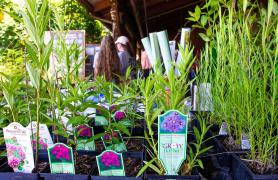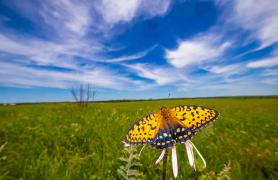Got a question for Ask MDC? Send it to AskMDC@mdc.mo.gov or call 573-522-4115, ext. 3848.
Q: What kind of spider is this?
This is an arrowshaped micrathena (Micrathena sagittata).
Female micrathenas spin intricate, circular webs where they commonly are seen resting. The males are small and rarely seen.
Protruding from the females’ yellow abdomens are three pairs of tubercles, tipped with black and red at the base. With a little imagination, these spiders’ abdomens resemble a rock musician’s ”Flying V” electric guitar.
As orbweavers, micrathenas capture small insects in the strands of their webs and deliver enough venom to subdue their prey. The spider then waits, returning later to ingest the prey’s liquifying innards.
Although they are ferocious predators of small insects, these spiders — by reducing the number of mosquitos and leaf hoppers — perform a valuable service to humans as a type of natural, nontoxic pest control. Hummingbirds, vireos, and warblers harvest the webbing to use in building their own nests. And many birds steal trapped insects from the spiders’ webs to eat themselves.
Micrathenas prefer open woods and backyards. For more information, visit short.mdc.mo.gov/4Su.
Q: Can you identify this mushroom?
This mushroom is commonly called wood ear or jelly ear (Auricularia americana).
This reddish-brown to grayish-black mushroom is in season from May through November. It tends to grow in groups on the decaying wood of hardwoods or conifers, especially in rainy, damp conditions. A tell-tale characteristic is this mushroom’s gelatinous flesh. Although it can be confused with other cup fungi, wood ear is rubbery, not brittle, and grows in irregular shapes.
Q: I came across this cylinder “nest” made of leaves. Can you tell me more about it?
This may be the work of the Christmas fern leafroller caterpillar (Herpetogramma sphingealis).
Scientists believe the caterpillars construct these leaf balls as shelters to avoid predators. The caterpillars also feed on the innermost fronds and defecate there, too, further obscuring their presence from predators. But they don’t damage the host fern enough to significantly harm the plant.
This species prefers the shady areas of dry forests. Adult moths can be seen from May through September. The unmemorable, grayish-brown moths range from Canada to Georgia and west to Missouri.
Also In This Issue

Finding space in your yard for native plants.

Tending to the queen of the prairie
And More...
This Issue's Staff
Editor - Angie Daly Morfeld
Associate Editor - Larry Archer
Photography Editor - Cliff White
Staff Writer - Kristie Hilgedick
Staff Writer - Joe Jerek
Staff Writer – Dianne Van Dien
Designer - Shawn Carey
Designer - Marci Porter
Photographer - Noppadol Paothong
Photographer - David Stonner
Circulation Manager - Laura Scheuler






















